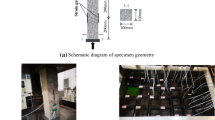Abstract
In order to investigate water and chloride ion transport in damaged concrete, three types of concrete were prepared, freeze-thawing (F-T) cycling and compressive loading were adopted to induce damage to concrete. Ultrasonic pulse velocity technique was used for evaluating the damage degree of concrete, and the defects of damaged concrete were also detected by X-CT. Water absorption and chloride ion penetrability were used for describing the transport properties of damaged concrete. Effects of damage degree on the water absorption rate and chloride ion penetrability were investigated in detail and the relationships were also established. The results show that the water absorption of concrete makes various responses to damage degree due to the difference of concrete type and damage method. For same concrete with similar damage degree, the water absorption rate of F-T damaged concrete is usually larger than that of concrete damaged by loading. The chloride ion penetrability of damaged concrete increases linearly with increasing damage degree, which is more sensitive to damage degree if the original penetrability of sound concrete is higher.
Similar content being viewed by others
References
Mehta PK, Monteiro JMP. Concrete Microstructure, Properties, Materials[ M]. Fourth Edition. New York: The McGraw-Hill Companies, Inc, 2014: 3
Desmettre C, Charron JP. Water Permeability of Reinforced Concrete with and Without Fiber Subjected to Static and Constant Tensile Loading[J]. Cem. Concr. Res., 2012, 42(7): 945–952
Wang Y, Wang XY, Scholz M, et al. A Physico-chemical Model for the Water Vapour Sorption Isotherm of Hardened Cementitious Materials[J]. Constr. Build. Mater., 2012, 35: 941–946
Jang SY, Bo SK, Oh BH. Effect of Crack width on Chloride Diffusion Coefficients of Concrete by Steady-state Migration Tests[J]. Cem. Concr. Res., 2011, 41(1): 9–19
Park SS, Kwon SJ, Sang HJ, et al. Analysis Technique for Chloride Penetration in Cracked Concrete Using Equivalent Diffusion and Permeation[J]. Constr. Build. Mater., 2012, 29(4): 183–192
Gowripalan N, Sirivivatnanon V, Lim CC. Chloride Diffusivity of Concrete Cracked in Flexure[J]. Cem. Concr. Res., 2000, 30(5): 725–730
Grassl P. A Lattice Approach to Model Flow in Cracked Concrete[J]. Cem. Concr. Compos., 2009, 31(7): 454–460
Solís-Carcaño R, Moreno EI. Evaluation of Concrete Made with Crushed Limestone Aggregate based on Ultrasonic Pulse Velocity[J]. Constr. Build. Mater., 2008, 22: 1225–1231
Trtnik G, Kavcic F, Turk G. Prediction of Concrete Strength Using Ultrasonic Pulse Velocity and Artificial Neural Networks[J]. Ultrason., 2009, 49(1): 53–60
Shariq M, Prasad J, Masood A. Studies in Ultrasonic Pulse Velocity of Concrete Containing GGBFS[J]. Constr. Build. Mater., 2013, 40(3): 944–950
Bogas JA, Gomes MG, Gomes A. Compressive Strength Evaluation of Structural Lightweight Concrete by Non-destructive Ultrasonic Pulse Velocity Method[J]. Ultrason., 2013, 53(5): 962–972
Yu H, Sun W, Zhang Y, et al. Durability of Concrete Subjected to the Combined Actions of Flexural Stress, Freeze-thaw Cycles and Bittern Solutions[J]. J. Wuhan Univ. Technol.-Mater. Sci. Ed., 2008, 23(6): 893–900
Chung CW, Shon CS, Kim YS. Chloride Ion Diffusivity of Fly Ash and Silica Fume Concretes Exposed to Freeze-thaw Cycles[J]. Constr. Build. Mater., 2010, 24(9): 1739–1745
Molero M, Aparicio S, Al-Assadi G, et al. Evaluation of Freeze-thaw Damage in Concrete by Ultrasonic Imaging[J]. Ndt E Int., 2012, 52(4): 86–94
Zhao J, Cai G, Gao D, et al. Influences of Freeze-thaw Cycle and Curing Time on Chloride Ion Penetration Resistance of Sulphoaluminate Cement Concrete[J]. Constr. Build. Mater., 2014, 53(2): 305–311
Standard Test Method for Measurement of Rate of Absorption of Water by Hydraulic Cement Concretes[S]. ASTM C1585–13, 2013
Standard Test Method for Electrical Indication of Concrete’s Ability to Resist Chloride Ion Penetration[S]. ASTM C1202–12, 2012
Wang Z, Zeng Q, Wu Y, et al. Relative Humidity and Deterioration of Concrete under Freeze-thaw Load[J]. Constr. Build. Mater., 2014, 62(7): 18–27
Powers TC, Willis TF. The Air Requirement of Frost Resistant Concrete [C]. In: Highway Research Board Proceedings, 1950, 29: 184–211
Scherer GW. Crystallization in Pores[J]. Cem. Concr. Res., 1999, 29(99): 1347–1358
Setzer MJ. Micro-Ice-Lens Formation in Porous Solid[J]. J. Colloid Interface Sci., 2001, 243(1): 193–201
Hall C. Water Sorptivity of Mortars and Concretes: A Review[J]. Mag. Concr. Res., 1989, 41(147): 51–61
Hall C, Hoff WD. Water Transport in Brick, Stone and Concrete[M]. Second Edition. London: Spon Press, 2012: 143–145
Vejmelková E, Pavliková M, Jerman M, et al. Free Water Intake as Means of Material Characterization[J]. J. Build. Phys., 2009, 33: 29–44
Castro J, Bentz D, Weiss J. Effect of Sample Conditioning on the Water Absorption of Concrete[J]. Cem. Concr. Compos., 2011, 33(8): 805–813
Author information
Authors and Affiliations
Corresponding author
Additional information
Funded by the Major State Basic Research Development Program of China (973 Program) (No. 2015CB655102), the National Natural Science Foundation of China (Nos. 51178106, 51378116 & 51408597), and the Scientific and Technological Research and Development plan of China Railway Corporation (No. 2013G001-A-2)
Rights and permissions
About this article
Cite this article
Yang, L., Sun, W., Liu, C. et al. Water absorption and chloride ion penetrability of concrete damaged by freeze-thawing and loading. J. Wuhan Univ. Technol.-Mat. Sci. Edit. 32, 330–337 (2017). https://doi.org/10.1007/s11595-017-1599-5
Received:
Accepted:
Published:
Issue Date:
DOI: https://doi.org/10.1007/s11595-017-1599-5




